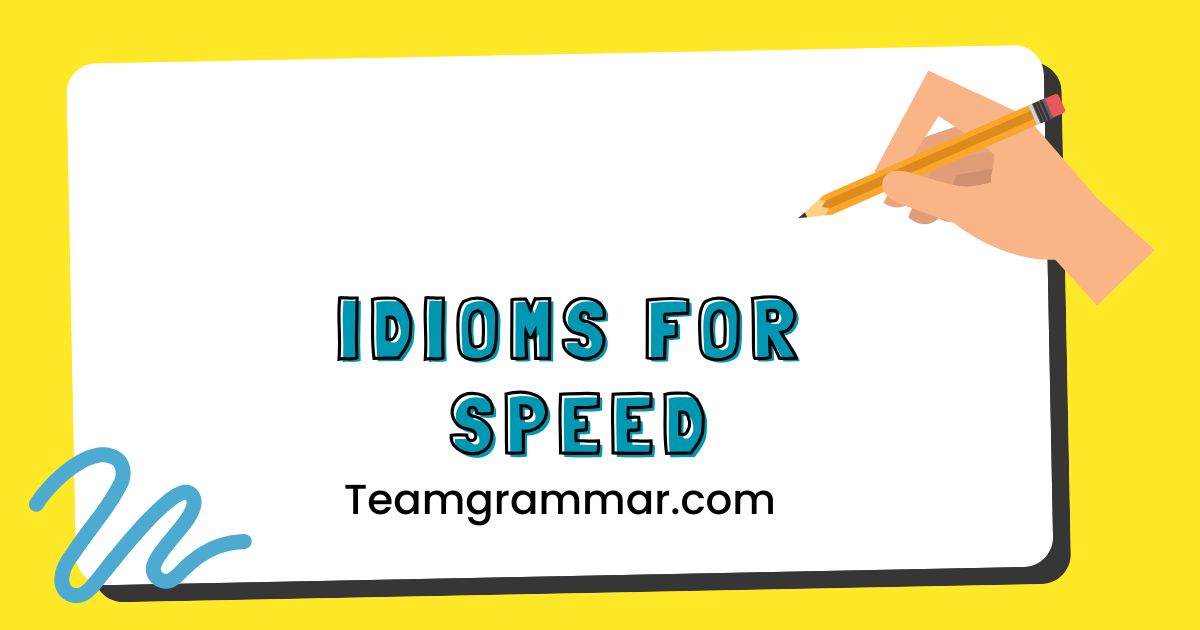47 Idioms for Speed: Mastering English Expressions
Understanding idioms related to speed is critical for mastering English fluency. These colorful expressions often convey nuanced meanings that go beyond their literal interpretations.
This article provides a comprehensive guide to idioms about speed, enhancing your comprehension and expressive abilities. Whether you’re an ESL learner, a student preparing for exams, or simply an English enthusiast, this guide will equip you with the knowledge to use these idioms confidently and accurately, enriching your communication and understanding of native English speakers.
Table of Contents
- Definition of Idioms for Speed
- Structural Breakdown
- Types and Categories of Idioms for Speed
- Examples of Idioms for Speed
- Usage Rules for Idioms for Speed
- Common Mistakes with Idioms for Speed
- Practice Exercises
- Advanced Topics
- Frequently Asked Questions
- Conclusion
Definition of Idioms for Speed
An idiom is a phrase or expression whose meaning cannot be understood from the literal meanings of its individual words. Instead, it has a figurative meaning known through common usage.
Idioms related to speed describe the rate at which something moves, progresses, or occurs. These idioms add color and depth to communication, helping to vividly express concepts related to velocity, pace, and urgency.
Understanding these idioms is crucial for both comprehending native English speakers and enhancing one’s own expressive abilities.
In essence, idioms for speed are a subset of idiomatic expressions that specifically relate to the concept of how quickly something happens or moves. They provide a more evocative and nuanced way of communicating speed than simply using words like “fast” or “slow.” For example, saying someone is “moving at a snail’s pace” paints a much clearer picture of their slowness than simply saying they are “slow.” The function of these idioms is to enhance communication by adding imagery and emotional context to the description of speed.
Structural Breakdown
Idioms for speed, like all idioms, often defy straightforward grammatical analysis. Their structure is fixed, and altering the words can destroy the idiom’s meaning.
However, some common structural patterns can be observed. Many idioms use verbs of motion or action combined with adverbs or prepositional phrases to describe speed.
Others use metaphorical comparisons to animals, objects, or events to convey a sense of pace. The key is to recognize the idiom as a unit rather than trying to analyze it word by word.
For instance, the idiom “in the blink of an eye” uses a prepositional phrase built around a noun (blink) to indicate extreme speed. Changing it to “in the wink of an eye” alters the meaning and reduces the idiom’s impact.
Similarly, “at a snail’s pace” utilizes a possessive noun (snail’s) to create a comparison that signifies slowness. The structural flexibility of idioms is limited; they must be used as they are commonly recognized to maintain their intended meaning and effect.
Types and Categories of Idioms for Speed
Idioms for speed can be broadly categorized based on the aspect of speed they describe. These categories help to understand the nuance each idiom brings to the conversation.
The three main categories are:
- Idioms describing literal speed
- Idioms describing progress or rate
- Idioms describing urgency
Idioms Describing Literal Speed
These idioms refer to the physical velocity of an object or person. They focus on how fast or slow something is physically moving.
Examples include phrases like “at lightning speed” or “dead slow.”
Idioms Describing Progress or Rate
These idioms describe the rate at which a task, project, or situation is advancing. They focus on the speed of development or completion, not necessarily physical movement.
Examples include “gain traction” or “lose steam.”
Idioms Describing Urgency
These idioms emphasize the need for quick action or immediate attention. They focus on the importance of acting swiftly in a particular situation.
Examples include “chop chop” or “pronto.”
Examples of Idioms for Speed
The following sections provide extensive examples of idioms for speed, categorized by the types described above. Each section includes tables with numerous examples to illustrate the usage and context of these idioms.
Examples of Idioms Describing Literal Speed
This table provides examples of idioms that describe literal speed, focusing on physical motion or velocity. Each idiom is accompanied by a definition and example sentence to illustrate its usage.
| Idiom | Definition | Example Sentence |
|---|---|---|
| At lightning speed | Extremely fast. | The race car zoomed past at lightning speed. |
| Like a bat out of hell | Very fast and often recklessly. | He ran like a bat out of hell when he heard the news. |
| In the blink of an eye | Extremely quickly; almost instantaneously. | The magician made the rabbit disappear in the blink of an eye. |
| Quick as a flash | Very fast. | She responded to the question quick as a flash. |
| At a snail’s pace | Very slowly. | Traffic was moving at a snail’s pace due to the accident. |
| Dead slow | Extremely slow. | The old computer was running dead slow. |
| With the speed of light | Extremely fast. | Information travels with the speed of light in the digital age. |
| Like greased lightning | Very fast and smoothly. | He slid into home base like greased lightning. |
| In a New York minute | Very quickly. | I’ll be there in a New York minute. |
| On the double | Very quickly; immediately. | The soldiers moved on the double when the order was given. |
| Full throttle | At maximum speed or effort. | The engine was running at full throttle. |
| Like a shot | Very quickly. | He left like a shot when he heard the bell. |
| At warp speed | Extremely fast, often used in a futuristic context. | The project progressed at warp speed once the funding was secured. |
| Flat out | As fast as possible. | The runner was going flat out to win the race. |
| At breakneck speed | Dangerously fast. | They were driving at breakneck speed down the winding road. |
| Go like the wind | To move very quickly. | The horse can go like the wind when it’s on the open field. |
| Make haste | To hurry; to act quickly. | We need to make haste if we want to catch the train. |
| Posthaste | Without delay; immediately. | The message was delivered posthaste to the king. |
| Double-time | At twice the speed. | The marching band moved at double-time during the parade. |
| Hit the ground running | To start something quickly and successfully. | She hit the ground running in her new job and quickly impressed everyone. |
| Burn rubber | To accelerate quickly in a vehicle, often causing the tires to squeal. | He burned rubber pulling out of the driveway. |
| Gather speed | To accelerate. | The train began to gather speed as it left the station. |
| Pick up speed | To increase in speed. | The car started to pick up speed on the open highway. |
| Lose speed | To decrease in speed. | The cyclist began to lose speed as he approached the steep hill. |
| Like a rocket | Very fast. | The stock price rose like a rocket after the company announced its new product. |
| Get a move on | To hurry. | We need to get a move on if we want to be on time. |
| In a heartbeat | Almost immediately; very quickly. | I would help you in a heartbeat if I could. |
| Run like hell | To run very fast, usually out of fear or urgency. | When the fire alarm went off, everyone ran like hell out of the building. |
Examples of Idioms Describing Progress or Rate
This table showcases idioms that describe the speed of progress or the rate at which something is developing, rather than physical speed. These idioms are useful for discussing projects, tasks, or situations that are advancing or stagnating.
| Idiom | Definition | Example Sentence |
|---|---|---|
| Gain traction | To start to become popular or successful. | The new marketing campaign is finally gaining traction. |
| Lose steam | To lose energy or enthusiasm. | The project started strong, but it’s beginning to lose steam. |
| Get the ball rolling | To start something. | Let’s get the ball rolling on this project by assigning tasks. |
| Pick up the pace | To increase the speed of progress. | We need to pick up the pace if we want to meet the deadline. |
| Slow the pace | To decrease the speed of progress. | We had to slow the pace to ensure accuracy. |
| Full speed ahead | To proceed with maximum effort and speed. | With the approval in hand, it’s full speed ahead on the construction project. |
| Back on track | To return to the original plan or progress after a delay. | After the setback, we’re finally back on track with the project. |
| Moving along | Progressing. | The negotiations are moving along smoothly. |
| Coming along | Developing or improving. | The garden is coming along nicely this year. |
| Make headway | To make progress. | We’re finally making headway on the research. |
| Keep up with | To progress at the same rate as something else. | It’s hard to keep up with the rapid changes in technology. |
| Lag behind | To progress slower than others. | The company is lagging behind in adopting new technologies. |
| Go the distance | To continue until the end, especially when it is difficult. | With determination, she went the distance and completed the marathon. |
| Keep the ball rolling | To maintain progress. | Let’s keep the ball rolling by having another meeting next week. |
| At a standstill | Not progressing; stopped. | The project is at a standstill due to lack of funding. |
| Gather momentum | To increase in force or speed. | The campaign began to gather momentum as more people joined. |
| Ahead of the curve | Innovating and progressing faster than the competition. | The company is ahead of the curve in developing new technologies. |
| A step ahead | To be slightly more advanced or successful than others. | Strategic planning kept them a step ahead of their competitors. |
| Slow to a crawl | To become very slow. | The traffic slowed to a crawl due to the accident. |
| Breakneck pace | A very fast and often unsustainable rate of progress. | The company grew at a breakneck pace, but it was exhausting for everyone involved. |
| In full swing | Operating at its peak activity level. | The party was in full swing by the time we arrived. |
| Gain ground | To make progress or get closer to a goal. | The team is gaining ground in the competition. |
| Inch forward | To move or progress very slowly. | The negotiations inched forward, but there were still major disagreements. |
| Run out of steam | To lose energy or enthusiasm and stop making progress. | The project ran out of steam when the funding was cut. |
| Stay the course | To continue doing something until it is finished, even if it is difficult. | Despite the challenges, we must stay the course and complete the project. |
| Keep pace with | To move or progress at the same rate as someone or something else. | We need to keep pace with the latest developments in technology. |
| At a good clip | Moving or progressing at a fast rate. | The project is moving along at a good clip. |
Examples of Idioms Describing Urgency
The following table provides idioms that emphasize the need for quick action or immediate attention. These expressions are often used in situations where time is of the essence.
| Idiom | Definition | Example Sentence |
|---|---|---|
| Chop chop | Hurry up. | Chop chop, we’re going to be late! |
| Pronto | Immediately; quickly. | I need that report, pronto! |
| ASAP (As Soon As Possible) | As quickly as possible. | Please send me the documents ASAP. |
| Right away | Immediately. | I’ll take care of it right away. |
| Without delay | Immediately; without waiting. | Action must be taken without delay. |
| On the spot | Immediately; at that location. | He was hired on the spot after the interview. |
| This instant | Immediately; right now. | Clean your room this instant! |
| At once | Immediately. | Come here at once! |
| Without further ado | Immediately; without any more delay. | Without further ado, let’s begin the presentation. |
| Drop everything | To stop doing what you are doing and deal with something immediately. | Drop everything, we have an emergency! |
| Hurry up | To act or move more quickly. | Hurry up, we’re going to miss the train! |
| Shake a leg | Hurry up. | Shake a leg, we need to leave now! |
| Get cracking | To start doing something quickly. | Let’s get cracking on this project. |
| Time is of the essence | It is very important to act quickly. | Time is of the essence in this situation, so we must act immediately. |
| Make time | To find time to do something. | I need to make time to finish this report. |
| Against the clock | Rushed and under pressure to meet a deadline. | We were working against the clock to finish the project on time. |
| Press for time | To be short on time. | I’m pressed for time, so let’s make this meeting brief. |
| In short order | Quickly; soon. | The repairs will be completed in short order. |
| Snap to it | To start doing something quickly and efficiently. | Snap to it, we have a lot of work to do! |
| On the fly | Done quickly and without much planning. | We had to make decisions on the fly during the crisis. |
| At short notice | With little warning or advance notice. | The meeting was scheduled at short notice. |
| Hotfoot it | To go quickly. | We had to hotfoot it to the station to catch the train. |
| On a tight schedule | Having very little time to complete something. | We’re on a tight schedule, so we need to work efficiently. |
| Every minute counts | Each moment is valuable and should not be wasted. | Every minute counts when trying to save a life. |
| In double-quick time | Very quickly. | The job was completed in double-quick time. |
| A race against time | A situation where you need to do something very quickly before it is too late. | Saving the endangered species is a race against time. |
| At the eleventh hour | At the last possible moment. | The funding came through at the eleventh hour. |
| No time to lose | There is no time to waste. | There’s no time to lose; we need to act now. |
Usage Rules for Idioms for Speed
Using idioms correctly requires understanding their specific context and nuances. Here are some rules to keep in mind:
- Use idioms in appropriate contexts: Consider your audience and the formality of the situation. Idioms are generally more suitable for informal settings.
- Maintain the idiom’s structure: Do not change the words or grammar of an idiom, as this can alter or destroy its meaning.
- Understand the figurative meaning: Ensure you know the figurative meaning of the idiom and use it appropriately.
- Be aware of cultural differences: Some idioms may not translate well across cultures or may have different meanings in different dialects.
It’s important to note that the overuse of idioms can make your speech sound unnatural or forced. Use them sparingly and only when they add value to your communication.
Pay attention to how native speakers use idioms and try to emulate their usage.
Common Mistakes with Idioms for Speed
Learners often make mistakes when using idioms, especially when they try to interpret them literally or alter their structure. Here are some common errors:
| Incorrect | Correct | Explanation |
|---|---|---|
| He ran like a hell bat. | He ran like a bat out of hell. | The correct idiom is “like a bat out of hell,” not “like a hell bat.” |
| The project is gaining trains. | The project is gaining traction. | The idiom is “gaining traction,” not “gaining trains.” |
| We need the report as fast as we can. | We need the report ASAP. | “ASAP” is the idiomatic abbreviation for “as soon as possible,” conveying urgency more directly. |
| Slow the pace up. | Slow the pace. | The correct idiom is “slow the pace,” not “slow the pace up.” |
| Come here at one. | Come here at once. | The correct idiom is “at once,” not “at one.” |
| Lets get the ball rolling around. | Lets get the ball rolling. | The correct idiom is “get the ball rolling,” not “get the ball rolling around.” |
Another common mistake is using idioms in inappropriate contexts. For example, using a very informal idiom in a formal business presentation would be inappropriate.
Always consider your audience and the situation when choosing idioms.
Practice Exercises
Test your understanding of idioms for speed with these practice exercises. Choose the correct idiom to complete each sentence.
| Question | Options | Answer |
|---|---|---|
| 1. The car was moving _______ due to the heavy rain. | a) at lightning speed b) at a snail’s pace c) like a rocket | b) at a snail’s pace |
| 2. We need that report _______, so please get it to me as soon as possible. | a) chop chop b) pronto c) full throttle | b) pronto |
| 3. She _______ in her new job and quickly impressed everyone. | a) lost steam b) hit the ground running c) slowed the pace | b) hit the ground running |
| 4. The project is finally _______. | a) gaining traction b) losing steam c) standing still | a) gaining traction |
| 5. They left _______ when they heard the alarm. | a) like a shot b) at a snail’s pace c) dead slow | a) like a shot |
| 6. _______, we’re going to be late! | a) Full speed ahead b) Chop chop c) At a standstill | b) Chop chop |
| 7. He was driving _______ down the winding road. | a) at breakneck speed b) at a snail’s pace c) like a turtle | a) at breakneck speed |
| 8. We’re working _______ to finish the project on time. | a) against the clock b) at our leisure c) in due time | a) against the clock |
| 9. The repairs will be completed _______. | a) in short order b) in the long run c) eventually | a) in short order |
| 10. The company is _______ in adopting new technologies. | a) keeping pace b) ahead of the curve c) lagging behind | c) lagging behind |
Advanced Topics
For advanced learners, exploring the etymology and historical context of idioms can provide deeper insights into their meanings and usage. Some idioms have origins in specific historical events, literature, or cultural practices.
Understanding these origins can enhance your appreciation for the richness and complexity of the English language.
Another advanced topic is the use of idioms in different dialects of English. While many idioms are common across all dialects, some are specific to certain regions or countries.
Learning these regional variations can help you to better understand and communicate with speakers from different parts of the world. For example, some idioms common in British English may be unfamiliar to speakers of American English, and vice versa.
Frequently Asked Questions
- What is the difference between an idiom and a metaphor?
An idiom is a phrase with a figurative meaning different from the literal meanings of its words, while a metaphor is a figure of speech that directly compares two unrelated things. Idioms are fixed expressions, while metaphors are more flexible and can be created spontaneously.
- How can I improve my understanding of idioms?
Read widely, listen to native speakers, and pay attention to the context in which idioms are used. Keep a notebook of new idioms you encounter and practice using them in your own speech and writing.
- Is it okay to use idioms in formal writing?
Generally, idioms are more suitable for informal writing and speech. In formal writing, it’s best to use more direct and literal language to avoid ambiguity.
- Are idioms the same in all English-speaking countries?
No, idioms can vary significantly between different English-speaking countries and regions. Some idioms are specific to certain dialects or cultures.
- How do I know when to use an idiom?
Use idioms when they add color and expressiveness to your communication, but avoid overuse. Consider your audience and the formality of the situation.
- Can I create my own idioms?
While you can create new phrases, they won’t be idioms unless they are widely adopted and understood by others. Idioms are established expressions with recognized figurative meanings.
- What is the best way to memorize idioms?
Use flashcards, practice using idioms in sentences, and try to incorporate them into your daily conversations. The more you use them, the better you’ll remember them.
- Why are idioms so difficult to learn?
Idioms are difficult because their meanings are not literal and must be learned through exposure and practice. They also vary across cultures and dialects, adding to the complexity.
- How do I avoid misusing idioms?
Pay close attention to the context in which idioms are used, and don’t try to interpret them literally. If you’re unsure of the meaning of an idiom, look it up in a dictionary or ask a native speaker.
- Are there any resources that can help me learn idioms?
Yes, there are many dictionaries of idioms, websites, and language learning apps that can help you learn and practice using idioms. Look for resources that provide examples and context.
Conclusion
Mastering idioms for speed can significantly enhance your English fluency and comprehension. These colorful expressions add depth and nuance to your communication, allowing you to express ideas more vividly.
By understanding the different types of idioms, following usage rules, and avoiding common mistakes, you can confidently incorporate them into your vocabulary. Continued practice and exposure to authentic English materials will further refine your skills and deepen your appreciation for the richness of the English language.
Remember to focus on context and usage when learning new idioms. Don’t be afraid to ask questions and seek clarification from native speakers.
With dedication and practice, you’ll be able to use idioms for speed effectively and enrich your communication in English. Keep practicing, and soon these expressions will come to you “in the blink of an eye!”







